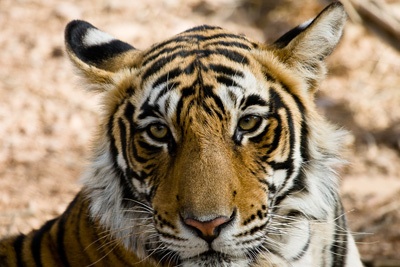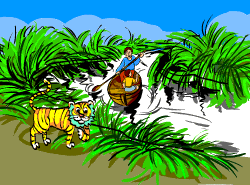“Which is the largest delta in the world?’ asked my 12-year-old niece, Tinku. She was ploughing though her geography holiday assignment. Sunderbans! replied my brother helpfully. The only one who was not happy with his answer was I. I wanted her to see the swamps, and the delicate ecosystem sustained by the mangrove forests there. And of course, I wanted her to see the place that had the world’s single largest population of tigers – the much talked about Royal Bengal Tiger.

The Sunderbans – Tiger’s Tale
So, one Friday morning we set out from Calcutta for the Sunderbans. There is no direct way of reaching Sunderbans. From Calcutta’s Babu Ghat it is a three-hour bus journey to Sonakhali village. From Sonakhali the journey is accomplished on boat via Gosava village, to Sajnekhali village, which acts as a gateway to Sunderbans.
Alternatively, one can take a train from Calcutta to Canning town and continue the journey to Sajnekhali on boat.
Whichever route one takes, the senses glide over the lush green of rural Bengal on the banks of the Ganga, to rest in the mouthwatering sight of local sweet shops loaded with rasogollas, sandesh and langchaas (a long version of the gulab jamun). My niece and I were no exceptions.
About Sunderbans
On the boat journey Tinku saw hundreds of birds perched precariously on something that seemed to be a dense mesh of floating roots. Her eyes widened.
“These are roots thrown out by the trees on the banks so as to get a firm foothold on the ever-moving loose sand. For, the frequent tides wash away sand continuously from one place to another. And these roots act as a natural protection against cyclonic storms that frequent the coastline,” I explained.
What are they called,” she asked. “Mangroves,” I said. Tinku shrieked. “This is what a mangrove is? Most of the students in my class think it is mango groves. Tell me some more so that I can impress them.”
I did, for I wanted to impress her. So I told her how the mangroves acted as a home to creatures like turtles, crabs, shrimps, lobsters, prawns, fish, storks, egrets and cranes, among others. Their numbers pointed to the ecological balance in the area.
As I spoke I realised with a shock that even I had clearly understood the reality of mangroves only now, after seeing them. Tinku was making me see things in a new way.
It was a mock growl by our co-passenger Mr Biswas that reminded her that the mangrove had one more illustrious inhabitant – the tiger. (The core area of the tiger reserve (1330 sq.km) is a designated National Park and has been declared a World Heritage Site. The area also comes under Project Tiger.)

The Sunderbans – Tiger’s Tale [Illustration by Anup Singh]
These cats are expert swimmers. I have also seen them catch fish and eat crab, boasted Mr Biswas. That was the cue for the others to join in.
“On an average 20 people are killed by the tigers every year,” said the boatman. From him we learnt that as humans took control over more and more land, the tigers found their habitats being destroyed. Since they were much closer to humans now, they took to killing cattle, and humans.
Tinku looked thoughtful.
By then she had been adopted by all the passengers, intent on telling her something about the Sunderbans. And, in between big mouthfuls of luchis and arloo bhaja provided by an avuncular gentleman, she learnt a great deal about white cranes, egrets, woodpeckers, terrapins.
Tinku’s list of animals to watch out for:
- The Royal Bengal Tigers, naturally.
- Golden-backed Woodpecker
- River Terrapin (Batagur baska)
- Estuarine Crocodile (Crocodilus porosus)
- White cranes – you can catch a picture of them in flight.And, based on our experience, we have made a checklist of the important things that should be kept in mind during the trip to Sunderbans.
Things to remember
- Drink only bottled water. Take food that does not spoil too soon in the hot tropical climate. As a safety measure medicines to treat diarrhoea.
- Keep a good torch with you but avoid venturing out after dark.
- Remember to take a big tube of mosquito repellent cream along.
- Winter and spring are the best time to visit the sanctuary.Some days ago I got an ecstatic letter from Tinku saying that her teachers had praised her for a very creative and perceptive piece on the Sunderbans that she had submitted as part of her holiday assignments.










